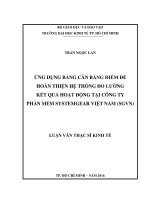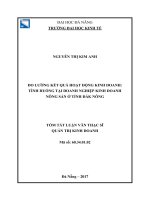Đo lường kết hợp-Đào Thị Minh An
Bạn đang xem bản rút gọn của tài liệu. Xem và tải ngay bản đầy đủ của tài liệu tại đây (388.13 KB, 59 trang )
§o l êng kÕt hîp
Dao Thi Minh An, MD PhD
03/10/15
o th minh an, MD
PhD- Khoa y t cụng
cng - i hc y H
Ni
Mục tiêu
Lập đ ợc các bảng tính nguy cơ đo l ờng sự kết hợp giữa
nguy cơ và bệnh
Định nghĩa đ ợc các chỉ số nguy cơ đo l ờng sự kết hợp giữa
nguy cơ và bệnh
Tính toán đ ợc các chỉ số nguy cơ đo l ờng sự kết hợp giữa
nguy cơ và bệnh
03/10/15
o th minh an, MD
PhD- Khoa y t cụng
cng - i hc y H
Ni
(Nghiên cứu Thuần tập)
Nguy co tuong doi (RR)= CIe/CI0 = a/(a + b) : c/(c + d)
Trong đó: CIe: Số mới mắc tích luỹ ở nhóm có phơi nhiễm
CI0: Số mới mắc tích luỹ ở nhóm không phơi nhiễm
(Nghiên cứu Bệnh-Chứng)
Tỷ suất chênh (Odd Ratio) OR= ad/bc
03/10/15
o th minh an, MD
PhD- Khoa y t cụng
cng - i hc y H
Ni
RR = CIe/CI0 = a/(a + b) : c/(c
+ d) (Nghiên cứu Thuần tập)
CIe: Số mới mắc tích luỹ ở
nhóm có phơi nhiễm
CI0: Số mới mắc tích luỹ ở
nhóm không phơi nhiễm
hay tỷ suất chênh (Odd Ratio)
OR= ad/bc
(Nghiên cứu Bệnh-Chứng)
Bảng
2x2
Hậu quả Tổng
Có Không
Phơi
nhiễm
a B A+b
K phơi
nhiễm
c d C+d
Tổn
g
A+c B+d A+b
+c+
d
03/10/15
o th minh an, MD
PhD- Khoa y t cụng
cng - i hc y H
Ni
Nguy cơ quy thuộc (Attributable Risk)
AR = Ie - Io = CIe - CIo
AR = CIe - CIo = a/(a+b) - c/(c+d)
Nguy cơ quy thuộc phần trăm (AR%)
AR% = AR/Ie x 100 = (Ie - Io)/Ie x 100
AR% = AR/Ie x 100
Nguy cơ quy thuộc quần thể (PAR)
PAR =IT -Io
hay PAR=(AR)(Pe)
IT: Tỷ lệ bệnh của quần thể
IO: Tỷ lệ mắc bệnh ở nhóm không phơi nhiễm
Pe: Tỷ lệ những cá thể có phơi nhiễm trong quần thể
Nguy cơ quy thuộc quần thể phần trăm (PAR%)
PAR% = PAR :IT x100
03/10/15
Đào thị minh an, MD
PhD- Khoa y tế công
cộng - Đại học y Hà
Nội
Prevalence
◆
Prevalence (a proportion):
–
the proportion of the population at a given time that
have the factor of interest.
–
Prevalence of an exposure
»
what proportion of this class have BMI > 25
–
Prevalence of outcome
»
what proportion of this class have hypertension
◆
Point Prevalence - existing cases at a point in time
◆
Period Prevalence - existing cases plus those
developing over a specified period of time
03/10/15
Đào thị minh an, MD
PhD- Khoa y tế công
cộng - Đại học y Hà
Nội
Prevalence
◆
Numerator
–
all those with the attribute at a particular time
◆
Denominator
–
the population at risk of having the attribute during that same time period
populationtheinNumber
casesprevailingofNumber
P =
03/10/15
Đào thị minh an, MD
PhD- Khoa y tế công
cộng - Đại học y Hà
Nội
Prevalence
Choice of denominator may be difficult.
◆
in 1997 there were 1854 cases of syphilis in Harris
County
◆
what should be used for the denominator?
◆
55 cases of a new disease reported in three states
◆
what should be used for the denominator?
03/10/15
Đào thị minh an, MD
PhD- Khoa y tế công
cộng - Đại học y Hà
Nội
Incidence
◆
Incidence density: the probability (risk) of an individual
developing the disease (outcome) during a specific period of
time, using total person-time as the denominator. One
subject followed one year contributes one person-year (PY).
time-person Total
period given time
a during disease of casesNumber
=
density
I
03/10/15
Đào thị minh an, MD
PhD- Khoa y tế công
cộng - Đại học y Hà
Nội
Incidence
◆
Cumulative Incidence: the probability (risk) of an
individual developing the disease (outcome) during
a specific period of time.
study theof start theat riskat Population
period study a over disease of cases new Number
=I
03/10/15
Đào thị minh an, MD
PhD- Khoa y tế công
cộng - Đại học y Hà
Nội
Incidence, Prevalence
What was prevalence of disease in 1992?
What is risk of developing disease within 2 years?
19941986 1988 1990 1992
D
E
F
B
C
Onset
A
1 case (A) / 4 subjects) = 25%
03/10/15
Đào thị minh an, MD
PhD- Khoa y tế công
cộng - Đại học y Hà
Nội
Incidence, Prevalence
4
6
8
E
F
0
2
Onset
A
B
C
D
Incidence within 2 years: 1/6 = 17%
03/10/15
Đào thị minh an, MD
PhD- Khoa y tế công
cộng - Đại học y Hà
Nội
Measure of Disease Association
◆
Ratios:
rate ratio, risk ratio or relative risk (all abbreviated
RR)
odds ratio (OR), and
prevalence ratios.
◆
Difference measurements of disease frequencies
include: attributable risk
03/10/15
Đào thị minh an, MD
PhD- Khoa y tế công
cộng - Đại học y Hà
Nội
Case Reports and Medical Advancement
These all started with case reports - what study design
next?
Lyme Disease (1975)
Legionellosis (1976)
AIDS (1981)
Hantavirus (1993)
DES exposure (1989)
EMS l -tryptophan (1970)
TSS (1980)
03/10/15
Đào thị minh an, MD
PhD- Khoa y tế công
cộng - Đại học y Hà
Nội
What next?
◆
CDC outbreak investigation guidelines
–
create case definition
–
active case finding
–
descriptive epidemiology
»
characterize the cases: person, place, time
–
formulate hypotheses
–
test hypotheses with case-control studies
03/10/15
Đào thị minh an, MD
PhD- Khoa y tế công
cộng - Đại học y Hà
Nội
The case-control study
◆
Retrospective study design
–
identifies cases
–
finds controls
–
asks about history of exposure
◆
Measure of association
–
odds ratio
03/10/15
Đào thị minh an, MD
PhD- Khoa y tế công
cộng - Đại học y Hà
Nội
Retrospective vs. prospective study designs
Retrospective vs. prospective study designs
dc
b
a
Present
(Cases)
Absent
(Controls)
Disease
Retrospective
(Case-control)
Present
(Exposed)
Absent
(Not Exposed)
Risk Factor
Prospective
(Cohort)
03/10/15
Đào thị minh an, MD
PhD- Khoa y tế công
cộng - Đại học y Hà
Nội
Case control studies
Case control studies
dc
ba
Yes No
Disease Status
Yes
No
Exposure
Status
a +b
c +d
b + da + c N
Total
03/10/15
Đào thị minh an, MD
PhD- Khoa y tế công
cộng - Đại học y Hà
Nội
Case-control studies
Case-control studies
◆
Selection of cases
Selection of cases
–
Case definition is very important
–
All cases have an equal probability for
selection: reduce selection bias
◆
Selection of controls
Selection of controls
–
Identical in every respect except disease of
interest
03/10/15
Đào thị minh an, MD
PhD- Khoa y tế công
cộng - Đại học y Hà
Nội
Case control studies
Case control studies
Strengths
Strengths
◆
Good for unusual or
rare diseases
◆
Smaller in size, quick,
easy, cost-effective
◆
Can use secondary
data on disease
◆
More easily replicated
◆
Can test hypotheses
Weaknesses
Weaknesses
◆
Uncertainty is exposure-
disease time relationship
◆
Representativeness of
cases or controls
◆
Memory problems
◆
Rare exposure a problem
◆
Survivor problem
◆
Bias potential (selection)
03/10/15
Đào thị minh an, MD
PhD- Khoa y tế công
cộng - Đại học y Hà
Nội
Case-control and the Odds Ratio
Case-control and the Odds Ratio
a b
c+d
a+b
a+c
d
c
Nb+d
Y N
Y
N
Disease
Exposure
Odds of exposure if case = [a / (a+c)] / [c / (a+c)] = a/c
Odds of exposure if control = [b / (b+d)] / [d /(b+d)] = b/d
Odds exposure given disease = (a/c)/(b/d) = (a*d)/(c*b)
How much risk
is too much risk?
03/10/15
Đào thị minh an, MD
PhD- Khoa y tế công
cộng - Đại học y Hà
Nội
Case-control and the Odds Ratio
Case-control and the Odds Ratio
Y N
Y
N
Cases Controls
Exposed 70 30 100
RR = 70/100
÷
30/100 = 2.3
Not Exposed 30 70 100
OR = 70/30
÷
30/70 = 5.4
100 100 200
Cases Controls
Exposed 70 300 370
RR = 70/100
÷
300/1000 = 4.6
Not Exposed 30 700 730
OR = 70/30
÷
30/70 = 5.4
100 1000 1100
03/10/15
Đào thị minh an, MD
PhD- Khoa y tế công
cộng - Đại học y Hà
Nội
TSS - 3 case-control studies
Cases Controls
Tampon users 50 43 reported p=0.02
Non-users 0 7
Cases Controls
Tampon users 30 71 reported p=0.014
Non-users 1 22
Cases Controls
Tampon users 12 32 p = 0.20
Non-users 0 8
(30/1) / (71/22) =
6.4
(50/0) / (43/7)
=
17.4
(12/0) / (32/8) =
6.5
NOTE: A correction factor of 0.5 was added to each cell when 1 cell contained 0
03/10/15
Đào thị minh an, MD
PhD- Khoa y tế công
cộng - Đại học y Hà
Nội
Study Methods
◆
CDC - 1: 52 TSS cases with age-matched
acquaintance controls
◆
Wisconsin Study: 31 cases, 93 controls from
gynecologic clinics, matched only for menstruation
◆
Utah: 12 TSS cases, 40 neighborhood-matched
controls
03/10/15
Đào thị minh an, MD
PhD- Khoa y tế công
cộng - Đại học y Hà
Nội
Matched Pair analysis
Controls
Cases Exposed Unexposed Total
Exposed 33 16 49
Unexposed 1 2 3
Total 34 18 52
Cases Controls Total
Exposed 49 34 83
Unexposed 3 18 21
Total 52 52 104
OR = 16 /1 = 16
How many cases used tampons continually?
How many cases did not use tampons continually?
What about controls?









